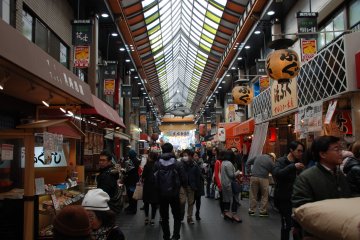
ตลาดคุโระมอนแห่งโอซาก้า
Guillaume Doréตลาดคุโระมอน-อิชิบะในโอซาก้าเป็นแหล่งขายอาหารหลากหลายชนิด สวรรค์ของนักกินทั่วโลก

Kuromon Market, or Kuromon Ichiba, is a staple destination among tourists and residents alike thanks to its abundance of fresh fish, meat, fruits, vegetables, sweets, clothes, and household/ miscellaneous items. The over 170-year old shopping street extends 580-meters long and is home to approximately 150 shops. Peruse large, commercialized shops alongside mom-and-pop spots and immerse yourself in the preserved food culture of Osaka. The lively atmosphere of shoppers, street food vendors, and tantalizing aromas will make for an unforgettable shopping experience.
The historic market, officially established in 1902 with the name Enmyoji Ichiba, quickly gained the nickname Kuromon Ichiba, which translates to Black Gate Market, due to the nearby Enmyoji Temple’s renowned black-painted gate. Although the temple was completely destroyed by fire in the early 20th century, the market’s name still persists today.
Although Kuromon Market has become a popular tourist destination, it still retains an authentic feel thanks to its local shoppers, cultural offerings, and down-to-earth vibes. The street is full of exciting finds, so be sure to explore them all! Pick up some preserved and pickled vegetables, wasabi root, bamboo shoots, wagyu beef, fugu (blowfish), strawberry daifuku (mochi covered strawberries), anime merchandise, or second-hand kimonos, to name a few.
Given that you are surrounded by food, why not try some as well? Thankfully, the market is a hotspot for street food and quick bites on the go. Try some takoyaki, grilled scallops, sushi, oden (assortment of meat skewers, meatballs, fishcake, and daikon radish in a light soy-flavored dashi broth), kushisei (deep-fried meat skewers), okonomiyaki, fresh fruit juice, and so much more. Make sure you come to the market hungry and enjoy Osaka’s cuisine! As you explore the market please be mindful of your trash and support the cleanliness of the area.
Towards the southern end of the market is the Kuromon Information Center. The center is a wonderful place to unwind after hours of walking and offers a seating area, toilets, a diaper changing table, a baggage counter, a currency exchange machine, and Chinese- and English-speaking staff onsite.
Kuromon Market is about a 5-minute walk from Nipponbashi Station and a 10-minute walk from Namba Station.

ตลาดคุโระมอน-อิชิบะในโอซาก้าเป็นแหล่งขายอาหารหลากหลายชนิด สวรรค์ของนักกินทั่วโลก

รู้จักกันว่าเป็นครัวของโอซาก้า ย่านขายของคุโรมอน อิจิบะเต็มไปด้วยปลาสดและผักคุณภาพสูงจำนวนมหาศาล
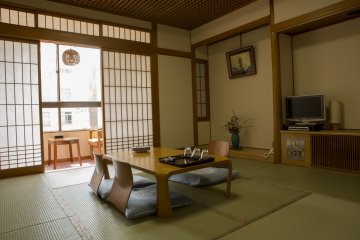
ในปัจจุบันยุค 60 ถือเป็นอดีตที่ห่างไกลไปแล้วแต่แก่นของยุคอันมหัศจรรย์นั้นยังคงหลงเหลืออยู่ ดังเช่นคาเนโยชิเรียวกังที่ถูกล้อมลอบไปด้วยแสงนีออนทันสมัยของโซเอะมอนโชที่ยังคงปรากฏให้เห็นอยู่
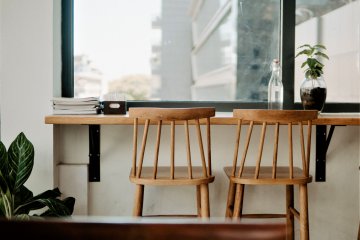
ห้องพักที่สะอาด เตียงที่นุ่มสบาย ของตกแต่งอันหรูหรา ใกล้กับระบบขนส่งสาธารณะ พนักงานที่พร้อมให้ความช่วยเหลือ เฟรเซอร์ เรสซิเดน นัมบะมีทุกสิ่งที่กล่าวมาทั้งหมด

โรงแรมสะอาดๆ ในราคาประหยัดที่มีทุกอย่างที่คุณต้องใช้ในการพักแรมรวมทั้งมีการให้บริการอินเตอร์เน็ตและอาหารเช้าฟรี และมีเครื่องซักรีดเสื้อผ้าแบบหยอดเหรียญด้วย

คามาตาเกะ อุด้ง (釜たけうどん /Kamatake Udon) เจ้าตำหรับ “ชิกุดามะเท็น บูคคาเคะ (Chikudamaten Bukkake)” อุด้งใส่ชิกุวะพร้อมไข่ยางมะตูมอันแสนอร่อยและเลื่องชื่อแห่งโอซาก้า
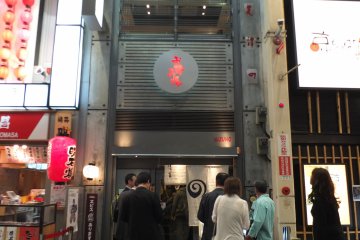
ร้านมิสุโนะ โอโคโนมิยากิ (Mizuno Okonomiyaki) ร้านโอโคโนมิยาเก่าแก่ ตั้งแต่ยุคหลังสงครามโลกครั้งที่ 2 ถ้าอยากรู้ว่าร้านนี้ดังขนาดไหน ลองถามคนในเมืองโอซาก้าดูสิครับ

กิน Okonomiyaki อาหารที่กำเนิดจากโอซาก้าที่ร้านที่เก่าแก่ที่สุด Mizuno
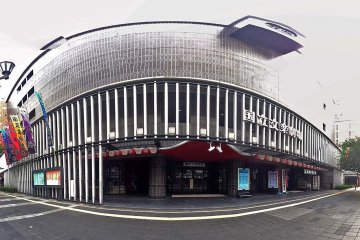
Osaka has been the capital of Bunraku, the traditional Japanese puppet theater, for many centuries. The National Bunraku Theater is a two-hall and exhibition room complex located in Chūō-ku, Osaka. The theater is now one of the few places where where the fascinating art form of bunraku can be seen. The complex opened in 1984 as the country's fourth national theater and became the headquarters of the Bunraku. The National Theater is operated by the Japanese Arts Council, an independent administrative body of the Ministry of Education, Culture, Sports, Science and Technology. English programs and headphones are available. The performances usually take place at three-week intervals in January, April, June, July / August and November.
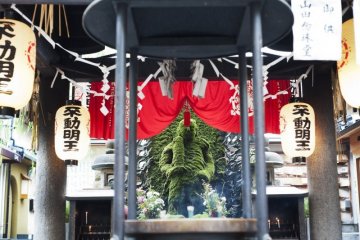
Among the hustle and bustle of Osaka’s renowned shopping and foodie street, Dotonbori, lies a cobblestone alleyway, Hozenji Yokocho, that leads visitors into old Japan. On the far western end of the alley stands the small, yet locally cherished Hozenji Temple. This Buddhist temple, built in 1637, is dedicated to Fudo Myoo, one of the five wisdom kings. During the 17th century, the temple played host to rakugo storytelling and stage performances in the up-and-coming entertainment district. What Hozenji lacks in space, it makes up for in ambience. Follow cobblestone streets past traditional storefronts to reach the modest temple. If you visit during the early morning, evening, or night, your journey will be bathed in the warm glow of lantern light. Once you reach Hozenji, pass under the entrance into the covered area and approach the principal object of worship, the Fudo Myoo statue, which has a bowl and ladle in front of it. It is customary to ladle water onto the statue when you pray for good luck, thus earning the statue the nickname Mizukake (water-throwing) Fudo. Due to years of prayer, the statue has become perpetually covered in moss, giving it a mystical aura. After praying to Fudo Myoo, enjoy the culture of the area by exploring Hozenji Yokocho’s okonomiyaki shops, izakayas, and multitude of restaurants. For a more high-energy experience, take a short walk to flashy Dotonbori and fill your night with street food, bar hopping, neon lights, and more.
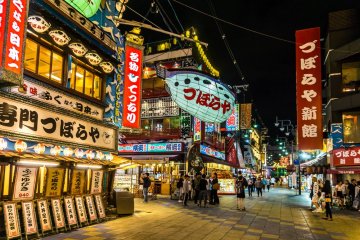
Dotonbori, located along the canal of the same name, is a street in the Namba district of Osaka’s Chuo ward that epitomizes the city’s nightlife. The colorful area is an explosion of neon lights, mouth watering street food, retro vibes, clubs, stores, and bars. A popular saying associated with the street is kuidaore, which roughly means to go bankrupt after spending an enormous amount of money on food. To experience the essence kuidaore (responsibly, of course) be sure to check out this renowned partying spot and lose yourself in the contagious energy! Roots in the 1600s The historic street started in the 1620s as a theater district with kabuki and bunraku (puppet) establishments along the canal. Over the years, many theaters closed as people lost interest in the traditional arts, and unfortunately, most of the remaining theaters were destroyed in bombing raids during WWII. Today, Shochiku-za Theater stands as the only reminder of the street’s theater roots. Today Today, Dotonbori is one of Osaka’s top tourist destinations. When the sun goes down, flashy neon advertisements light up along the canal and streets. The rainbow of colors illuminates the night air, creating an exciting atmosphere that matches Dotonbori’s offerings. Walk along the bustling street and lose yourself in the tantalizing food smells, energetic chatter, and hypnotizing sights. Embrace Kuidaore Food Culture With a phrase like kuidaore associated with the street, there is no doubt that Dotonbori takes its food culture seriously. The street is one of the best places to experience Osaka cuisine, and the area’s flamboyant restaurants themselves are a feast for the eyes. You will need multiple nights to enjoy all of the street’s wonders! For a personalized and unforgettable experience, book a food tour with a local who can guide you through the best spots. Discover Dotonbori's top restaurants. See the Sights! After, while, or before you eat, explore the vibrant area. Seemingly every spot of the street is filled with dazzling lights, historic vibes, and unique charm. Listed below are some of Dotonbori’s staple destinations. Though be sure to explore off of the beaten path and discover the street’s many wonders yourself!